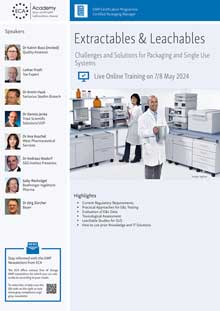Revised Ph. Eur. monographs: Plastic Syringes and Blood Transfusion Sets

Recommendation
7/8 May 2024
Challenges and Solutions for Packaging and Single Use Systems
Two Ph. Eur. (European Pharmacopoeia) packaging chapters have been revised and published for comment in Pharmeuropa 30.1:
- 3.2.8. Sterile single-use plastic syringes,
- 3.2.6. Sets for the transfusion of blood and blood components.
The deadline for comments is March 31, 2018.
Both chapters have been revised regarding the test on ethylene oxide. A modernization of the gas chromatography method (including the replacement of the packed column by a capillary column coupled with mass spectrometry (MS)) is proposed. Furthermore, the ethylene oxide extraction step is to be adapted to the type of plastic material to be examined in order to maximize the release of ethylene oxide present.
The method has been validated and is considered suitable for the following materials:
- cyclo-olefin polymers (COP) and copolymers (COC),
- poly(vinyl chloride) (PVC),
- and polyurethane (PU).
The drafts emphasize that not all possible plastic materials under the scope of the general chapters have been evaluated so far. According to chapter 3.2.8 the most commonly used materials are polypropylene and polyethylene. Therefore, users are requested to provide data concerning other plastic materials, including, but not restricted to, polyethylene, polypropylene and non-plasticized PVC, with a special emphasis on the validation of the ethylene oxide extraction step.
Additionally, in chapter 3.2.8, the test for pyrogens (2.6.8) has been replaced by the test for bacterial endotoxins (2.6.14) following the provisions of the European Convention for the Protection of Vertebrate Animals used for Experimental and Other Scientific Purposes. However, chapter 3.2.6 has not yet been revised regarding the test for pyrogens. Users are invited to provide data on alternative validated methods for 3.2.6 and for the testing of sterile plastic containers for human blood and blood components (Ph. Eur. chapter 3.2.3).
Following your registration on the Pharmeuropa website you will have access to the full text of the two revised chapters.
Related GMP News
GMP Conferences by Topics
- General Quality Assurance and GMP Compliance Topics
- Hygiene
- General Microbiology Topics
- Regulatory Affairs
- Development
- General Analytics Topics
- Good Distribution Practice
- Sterile Manufacturing
- Computer Validation
- General Qualification/Validation Topics
- General Engineering Topics
- APIs/Excipients
- GMP Basic Training Courses
- Medical Devices and Combination Products
- Packaging and Packaging Material
- Data Integrity
- Qualified Person (QP)
- GMP Auditing
- Documentation
- Cleaning Validation
- General IT Compliance Topics
- Impurities
- OOS / OOE / OOT
- Material Testing
- Validation of Analytical Methods
- Analytical Instrument Qualification
- Stability Testing
- Microbiological Testing
- Technology
- General Manufacturing Topics
- Solid Dosage Forms/Semi-Solid Dosage Forms
- Biotechnology/Blood/ATMP
- Herbal Drug Products/Cannabis/Radiopharmaceuticals
- Others




